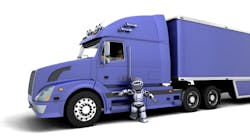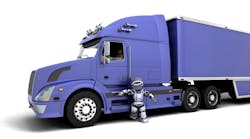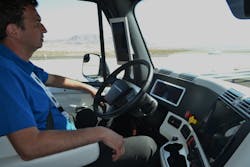Robots out to get truckers' jobs? Tech guru says time is nigh
As the saying goes, to a hammer everything looks like a nail. To a Silicon Valley guy, everything needs to be automated and “disrupted.” And in a recent post on Tech Crunch, the online source for technology industry news and gossip, one of the Valley’s currently coolest kids spells out the end of truck drivers.
“No technology will automate away more jobs—or drive more economic efficiency—than the driverless truck,” writes Ryan Peterson in a piece that’s garnered nearly 20,000 shares and more than 100 comments.
Who’s Ryan Peterson? He’s the founder and CEO of Flexport, a hot startup that provides web-based international freight forwarding. Or, as a Bloomberg headline calls it, “the Uber of the oceans.” Peterson has backing from some serious players, so he has some cred—even if more than a few folks are skeptical that something as complex as global shipping can be reduced to an app. But, hey, it’s a $100 billion dollar market, so why not make a play for a cut.Anyway, he’s not just some crank popping off on a nerd blog. Back to trucking.
Broadly, Peterson reasonably sums up the case for driverless trucks, although it’s conventional wisdom: A big part of the cost of moving freight by truck is the driver’s wage—but drivers are limited by regulation in how long they drive each day. Autonomous trucks would reduce the driver cost while doubling a rig’s productivity.
He also writes that because truckers are paid by the mile, they drive faster than is optimal for fuel efficiency—and robots don’t mind going 45 mph.
And then there’s the anticipated safety improvement with autonomous vehicles, to say nothing of the fact that driving a truck is “a grueling job that young people don’t really want to do.”
But he does caution that losing 1.6 million trucking jobs—and the resulting impact on the support network, such as truck stop buffets—will be “a devastating blow to the economy.”
And there are the regulatory issues, and the need to adjust the highway infrastructure to better support driverless trucks. Peterson anticipates staging areas where the driver and the autonomous vehicle will part ways for the long highway portion of the move. And 45-mph trucks will likely need their own lane.
“Yet the benefits from adopting [driverless trucks] will be so huge that we can’t simply outlaw it,” he writes. “A 400 percent price-performance improvement in ground transportation networks will represent an incredible boost to human well-being.”
Most importantly, he concludes, this isn’t some abstract and remote future he’s considering. Recent autonomous technology demonstrations in Europe show that “driverless trucking is right around the corner” and we can’t afford to put off considering how this is all going to work.
Well, yes and no. Or rather, no—driverless trucks are not right around the corner. Sandeep Kar of Frost & Sullivan said last August that Level 4 automation, meaning no driver in the cab, is “way out there.” He projects that there will be no such trucks on the public highways by 2025, and only 300 by 2035. And the projection for Level 3 technology is just 3,160 trucks within 10 years, although that total surges to almost 41,000 by 2035.
And yes, we do need to have the conversation now as interim steps are more widely adopted. As the autonomous truck demonstrations clearly show, the technology to take over driving in typical highway situations is ready today—but the market isn’t. Truck buyers are increasingly investing in the advanced safety technologies that are the building blocks of driverless vehicles: radar and camera systems to maintain the lane and trigger braking, for example, and GPS-based predictive cruise control. But the market penetration is still very low. Simply, this technology needs to demonstrably pay for itself with safety and efficiency improvements for truck operators.
And that’s the why I continue to look to platooning as the bellwether technology: Can these systems be combined and used in a way that justifies the investment, even with a driver (and his salary) still in the cab? Would FMCSA be willing to extend the hours limits for drivers in these vehicles, if the safety improvements are indeed there?
If so, the next generation of truck drivers is going to have its cake and eat it to. More pay for less work: that’s the technology we should support. And let their kids worry about whether robots are taking all the cool jobs.
Your thoughts?
About the Author
Kevin Jones 1
Editor
Kevin has served as editor-in-chief of Trailer/Body Builders magazine since 2017—just the third editor in the magazine’s 60 years. He is also editorial director for Endeavor Business Media’s Commercial Vehicle group, which includes FleetOwner, Bulk Transporter, Refrigerated Transporter, American Trucker, and Fleet Maintenance magazines and websites.


